We need to know the behavior of as . In this section, we define limits at infinity and show how these limits affect the graph of a function.
We begin by examining what it means for a function to have a finite limit at infinity. Then we study the idea of a function with an infinite limit at infinity. Back in Introduction to Functions and Graphs, we looked at vertical asymptotes; in this section we deal with horizontal and oblique asymptotes.
Limits at Infinity and Horizontal Asymptotes
Recall that means becomes arbitrarily close to as long as is sufficiently close to . We can extend this idea to limits at infinity. For example, consider the function . As can be seen graphically in Figure and numerically in Table, as the values of get larger, the values of approach . We say the limit as approaches of is and write . Similarly, for , as the values get larger, the values of approaches . We say the limit as approaches of is and write .
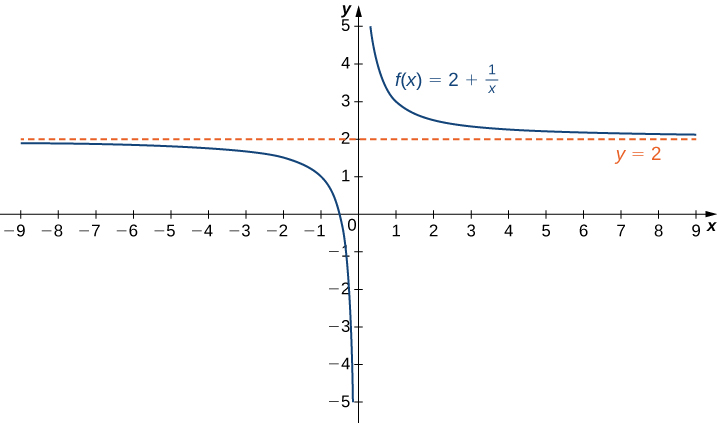
Figure :The function approaches the asymptote as approaches .
Values of a function as
|
10 |
100 |
1,000 |
10,000 |
|
2.1 |
2.01 |
2.001 |
2.0001 |
|
−10 |
−100 |
−1000 |
−10,000 |
|
1.9 |
1.99 |
1.999 |
1.9999 |
More generally, for any function , we say the limit as of is if becomes arbitrarily close to as long as is sufficiently large. In that case, we write . Similarly, we say the limit as of is if becomes arbitrarily close to as long as and is sufficiently large. In that case, we write . We now look at the definition of a function having a limit at infinity.
Definition: limit at infinity (Informal)
If the values of become arbitrarily close to as becomes sufficiently large, we say the function has a limit at infinity and write
If the values of becomes arbitrarily close to for as becomes sufficiently large, we say that the function has a limit at negative infinity and write
If the values are getting arbitrarily close to some finite value as or , the graph of approaches the line . In that case, the line is a horizontal asymptote of (Figure). For example, for the function , since , the line is a horizontal asymptote of .
Definition: horizontal asymptote
If or , we say the line is a horizontal asymptote of .
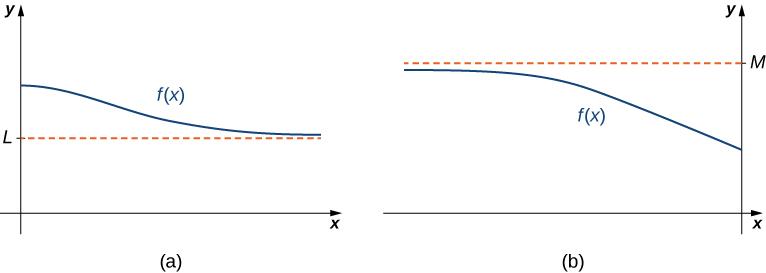
Figure : (a) As , the values of are getting arbitrarily close to . The line is a horizontal asymptote of . (b) As , the values of are getting arbitrarily close to . The line is a horizontal asymptote of .
A function cannot cross a vertical asymptote because the graph must approach infinity (or ) from at least one direction as approaches the vertical asymptote. However, a function may cross a horizontal asymptote. In fact, a function may cross a horizontal asymptote an unlimited number of times. For example, the function shown in Figure intersects the horizontal asymptote an infinite number of times as it oscillates around the asymptote with ever-decreasing amplitude.
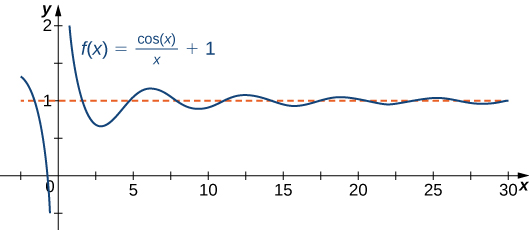
Figure : The graph of crosses its horizontal asymptote an infinite number of times.
The algebraic limit laws and squeeze theorem we introduced in Introduction to Limits also apply to limits at infinity. We illustrate how to use these laws to compute several limits at infinity.
Example : Computing Limits at Infinity
For each of the following functions , valuate and . Determine the horizontal asymptote(s) for .
Solution
a. Using the algebraic limit laws, we have
=5−2⋅0=5.
Similarly, . Therefore, has a horizontal asymptote of and approaches this horizontal asymptote as as shown in the following graph.
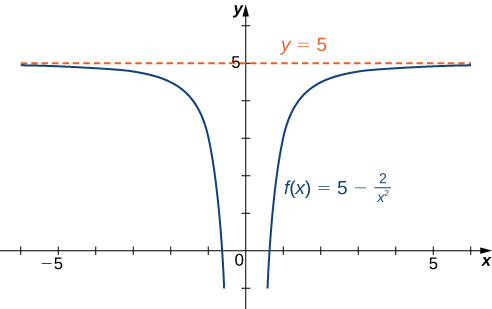
Figure : This function approaches a horizontal asymptote as
b. Since for all positive , we have
for all . Also, since
,
we can apply the squeeze theorem to conclude that
Similarly,
Thus, has a horizontal asymptote of and approaches this horizontal asymptote as as shown in the following graph.

Figure : This function crosses its horizontal asymptote multiple times.
c. To evaluate and , we first consider the graph of over the interval as shown in the following graph.
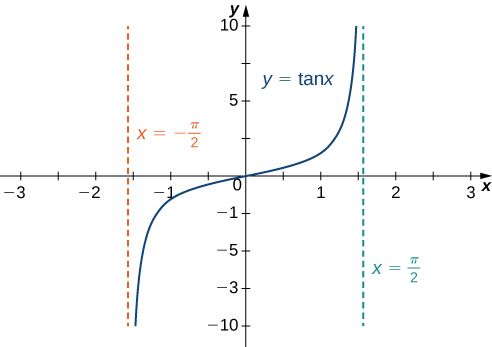
Figure : The graph of has vertical asymptotes at
Since
it follows that
Similarly, since
it follows that
As a result, and are horizontal asymptotes of as shown in the following graph.
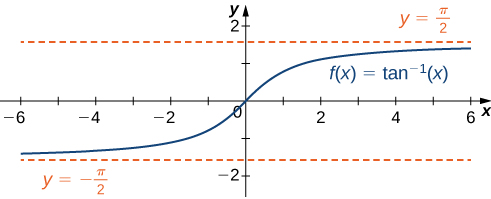
Figure : This function has two horizontal asymptotes.
Exercise
Evaluate and . Determine the horizontal asymptotes of if any.
- Hint
-
- Answer
-
Both limits are The line is a horizontal asymptote.
Infinite Limits at Infinity
Sometimes the values of a function become arbitrarily large as (or as ). In this case, we write (or ). On the other hand, if the values of are negative but become arbitrarily large in magnitude as (or as ), we write (or ).
For example, consider the function . As seen in Table and Figure, as the values become arbitrarily large. Therefore, . On the other hand, as , the values of are negative but become arbitrarily large in magnitude. Consequently,
|
10 |
20 |
50 |
100 |
1000 |
|
1000 |
8000 |
125,000 |
1,000,000 |
1,000,000,000 |
|
−10 |
−20 |
−50 |
−100 |
−1000 |
|
−1000 |
−8000 |
−125,000 |
−1,000,000 |
−1,000,000,000 |
Values of a power function as
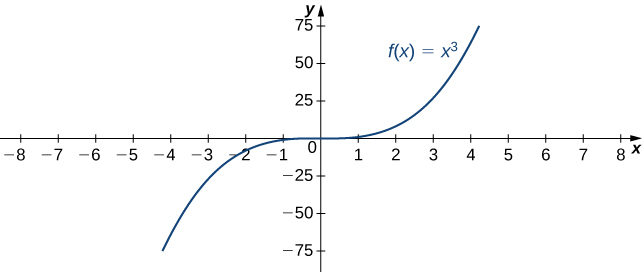
Figure : For this function, the functional values approach infinity as
Definition: infinite limit at infinity (Informal)
We say a function has an infinite limit at infinity and write
if becomes arbitrarily large for sufficiently large. We say a function has a negative infinite limit at infinity and write
if and becomes arbitrarily large for sufficiently large. Similarly, we can define infinite limits as
End Behavior
The behavior of a function as is called the function’s . At each of the function’s ends, the function could exhibit one of the following types of behavior:
- The function approaches a horizontal asymptote .
- The function or
- The function does not approach a finite limit, nor does it approach or . In this case, the function may have some oscillatory behavior.
Let’s consider several classes of functions here and look at the different types of end behaviors for these functions.
End Behavior for Polynomial Functions
Consider the power function where is a positive integer. From Figure and Figure, we see that
and
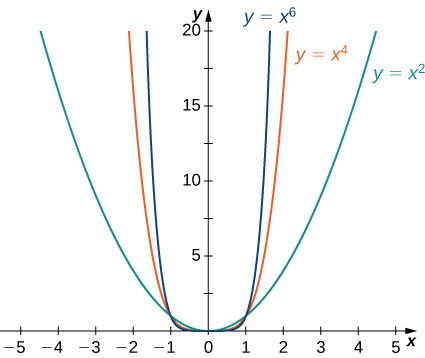
Figure : For power functions with an even power of \(n, \displaystyle \lim_{x→∞}x^n=∞= \displaystyle \lim_{x→−∞}x^n\).
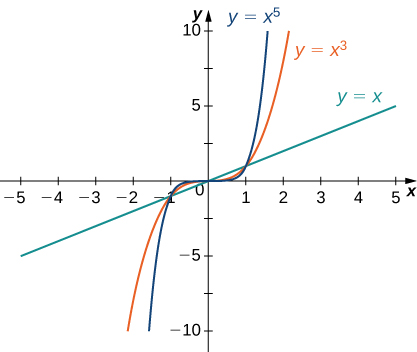
Figure : For power functions with an odd power of \(n, \;\displaystyle \lim_{x→∞}x^n=∞\) and
Using these facts, it is not difficult to evaluate and , where is any constant and is a positive integer. If , the graph of is a vertical stretch or compression of and therefore
and if .
If the graph of is a vertical stretch or compression combined with a reflection about the -axis, and therefore
and if
If in which case
Example : Limits at Infinity for Power Functions
For each function , evaluate and .
Solution:
- Since the coefficient of is , the graph of involves a vertical stretch and reflection of the graph of about the -axis. Therefore, and .
- Since the coefficient of is , the graph of is a vertical stretch of the graph of . Therefore, and .
Exercise
Let . Find .
- Hint
-
The coefficient is negative.
- Answer
-
We now look at how the limits at infinity for power functions can be used to determine for any polynomial function . Consider a polynomial function
of degree so that Factoring, we see that
As all the terms inside the parentheses approach zero except the first term. We conclude that
For example, the function behaves like as as shown in Figure and Table.
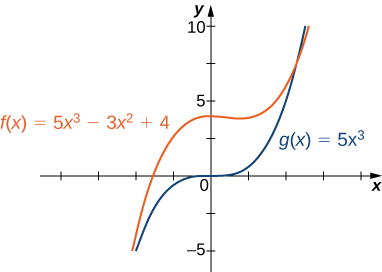
Figure : The end behavior of a polynomial is determined by the behavior of the term with the largest exponent.
|
10 |
100 |
1000 |
|
4704 |
4,970,004 |
4,997,000,004 |
|
5000 |
5,000,000 |
5,000,000,000 |
|
−10 |
−100 |
−000 |
|
−5296 |
−5,029,996 |
−5,002,999,996 |
|
−5000 |
−5,000,000 |
−5,000,000,000 |
A polynomial’s end behavior is determined by the term with the largest exponent
End Behavior for Algebraic Functions
The end behavior for rational functions and functions involving radicals is a little more complicated than for polynomials. In Example, we show that the limits at infinity of a rational function depend on the relationship between the degree of the numerator and the degree of the denominator. To evaluate the limits at infinity for a rational function, we divide the numerator and denominator by the highest power of appearing in the denominator. This determines which term in the overall expression dominates the behavior of the function at large values of .
Example : Determining End Behavior for Rational Functions
For each of the following functions, determine the limits as and Then, use this information to describe the end behavior of the function.
- (Note: The degree of the numerator and the denominator are the same.)
- (Note: The degree of numerator is less than the degree of the denominator.)
- in the denominator is x. Therefore, dividing the numerator and denominator by x and applying the algebraic limit laws, we see that
Solution
a. The highest power of in the denominator is . Therefore, dividing the numerator and denominator by and applying the algebraic limit laws, we see that
Since , we know that is a horizontal asymptote for this function as shown in the following graph.
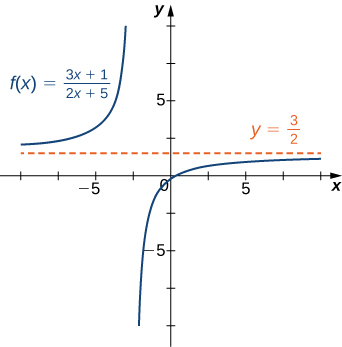
Figure : The graph of this rational function approaches a horizontal asymptote as
b. Since the largest power of appearing in the denominator is , divide the numerator and denominator by . After doing so and applying algebraic limit laws, we obtain
Therefore has a horizontal asymptote of as shown in the following graph.
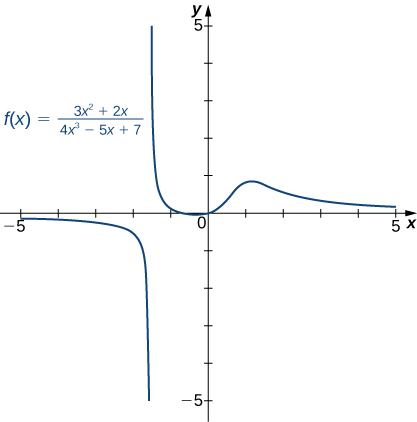
Figure : The graph of this rational function approaches the horizontal asymptote \(y=0\) as
c. Dividing the numerator and denominator by , we have
.
As , the denominator approaches . As , the numerator approaches . As , the numerator approaches . Therefore , whereas as shown in the following figure.
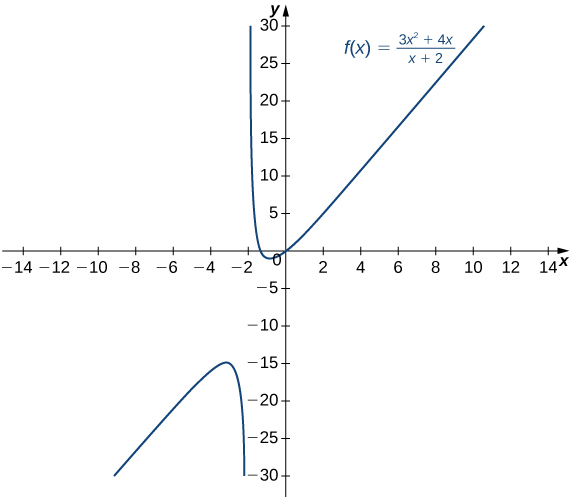
Figure : As , the values . As , the values
Exercise
Evaluate and use these limits to determine the end behavior of .
- Hint
-
Divide the numerator and denominator by .
- Answer
-
Before proceeding, consider the graph of shown in Figure. As and , the graph of appears almost linear. Although is certainly not a linear function, we now investigate why the graph of seems to be approaching a linear function. First, using long division of polynomials, we can write
.
Since as we conclude that
Therefore, the graph of approaches the line \)y=3x−2\) as . This line is known as an oblique asymptote for (Figure).
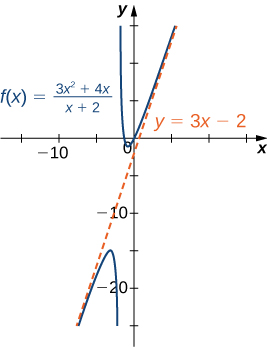
Figure : The graph of the rational function approaches the oblique asymptote as
We can summarize the results of Example to make the following conclusion regarding end behavior for rational functions. Consider a rational function
,
where and
1. If the degree of the numerator is the same as the degree of the denominator then has a horizontal asymptote of as
2. If the degree of the numerator is less than the degree of the denominator then has a horizontal asymptote of as
3. If the degree of the numerator is greater than the degree of the denominator then does not have a horizontal asymptote. The limits at infinity are either positive or negative infinity, depending on the signs of the leading terms. In addition, using long division, the function can be rewritten as
,
where the degree of is less than the degree of . As a result, . Therefore, the values of approach zero as . If the degree of is exactly one more than the degree of , the function is a linear function. In this case, we call an oblique asymptote.
Now let’s consider the end behavior for functions involving a radical.
Example : Determining End Behavior for a Function Involving a Radical
Find the limits as and for and describe the end behavior of .
Solution
Let’s use the same strategy as we did for rational functions: divide the numerator and denominator by a power of . To determine the appropriate power of , consider the expression in the denominator. Since
for large values of in effect appears just to the first power in the denominator. Therefore, we divide the numerator and denominator by . Then, using the fact that for for , and for all , we calculate the limits as follows:
.
Therefore, approaches the horizontal asymptote as and the horizontal asymptote as as shown in the following graph.

Figure :This function has two horizontal asymptotes and it crosses one of the asymptotes.
Exercise
Evaluate .
- Hint
-
Divide the numerator and denominator by
- Answer
-
Determining End Behavior for Transcendental Functions
The six basic trigonometric functions are periodic and do not approach a finite limit as For example, oscillates between (Figure). The tangent function has an infinite number of vertical asymptotes as ; therefore, it does not approach a finite limit nor does it approach as as shown in Figure.
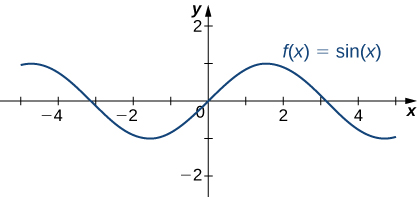
Figure :The function oscillates between as
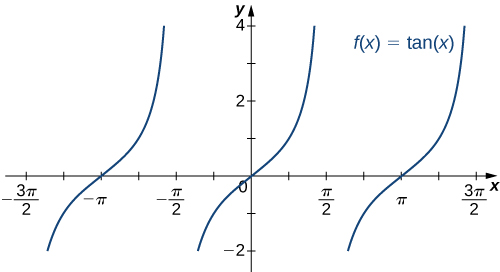
Figure : The function does not approach a limit and does not approach as
Recall that for any base the function is an exponential function with domain and range . If is increasing over `. If is decreasing over For the natural exponential function . Therefore, is increasing on ` and the range is ` The exponential function approaches as and approaches as as shown in Table and Figure.
End behavior of the natural exponential function
|
−5 |
−2 |
0 |
2 |
5 |
|
0.00674 |
0.135 |
1 |
7.389 |
148.413 |
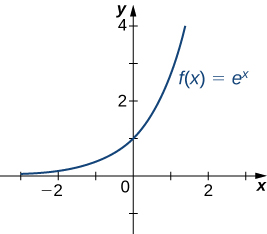
Figure : The exponential function approaches zero as and approaches as
Recall that the natural logarithm function is the inverse of the natural exponential function . Therefore, the domain of is and the range is . The graph of is the reflection of the graph of about the line . Therefore, as and as as shown in Figure and Table.
End behavior of the natural logarithm function
|
0.01 |
0.1 |
1 |
10 |
100 |
|
−4.605 |
−2.303 |
0 |
2.303 |
4.605 |
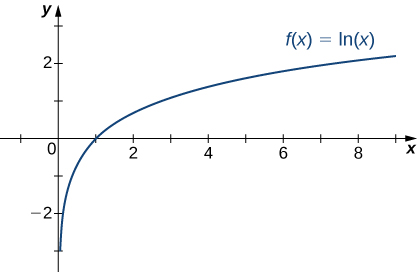
Figure : The natural logarithm function approaches as
Example : Determining End Behavior for a Transcendental Function
Find the limits as and for and describe the end behavior of
Solution
To find the limit as divide the numerator and denominator by :
As shown in Figure, as Therefore,
.
We conclude that , and the graph of approaches the horizontal asymptote as To find the limit as , use the fact that as to conclude that , and therefore the graph of approaches the horizontal asymptote as .
Exercise
Find the limits as and for
- Hint
-
and
- Answer
-
Key Concepts
- The limit of is as (or as if the values become arbitrarily close to as becomes sufficiently large.
- The limit of is as if becomes arbitrarily large as becomes sufficiently large. The limit of is as if and becomes arbitrarily large as becomes sufficiently large. We can define the limit of as approaches similarly.
- For a polynomial function where , the end behavior is determined by the leading term . If approaches or at each end.
- For a rational function the end behavior is determined by the relationship between the degree of and the degree of . If the degree of is less than the degree of , the line is a horizontal asymptote for . If the degree of is equal to the degree of , then the line is a horizontal asymptote, where and are the leading coefficients of and , respectively. If the degree of is greater than the degree of , then approaches or at each end. NOTE: These rules are good to check your work, but be aware that you need to justify your conclusions with Calculus, namely working out the limits as approaches or .
Glossary
- end behavior
- the behavior of a function as and
- horizontal asymptote
- if \displaystyle(\lim_{x→∞}f(x)=L\) or , then is a horizontal asymptote of
- infinite limit at infinity
- a function that becomes arbitrarily large as x becomes large
- limit at infinity
- a function that becomes arbitrarily large as becomes large
- oblique asymptote
- the line if approaches it as or






















